When selecting hiking jackets for windy and cold weather, important factors include insulation quality, breathability, waterproofing, and durability. Ideal choices include the Fjällräven Bergtagen Eco-Shell, Haglöfs Spitz GTX Pro, and Mountain Equipment Makalu. These jackets offer impressive waterproof ratings and breathability, essential for moisture management. Synthetic insulation guarantees warmth even in wet conditions, while features like adjustable hoods and hems enhance fit and heat retention. Windproof technologies are critical, with jackets like the Black Diamond Distance Wind Shell providing effective wind blockage. Lightweight, water-repellent options should also be considered. Exploring further will uncover more tailored insights on these jackets.
Key Takeaways
- Fjällräven Bergtagen Eco-Shell offers superior waterproofing and breathability, ideal for harsh winter hiking conditions.
- Mountain Equipment Makalu balances affordability with robust Gore-Tex fabric, providing effective insulation and protection against cold and wind.
- Haglöfs Spitz GTX Pro features 3L Gore-Tex Pro, ensuring maximum breathability and waterproofing for rigorous outdoor activities.
- Black Diamond Distance Wind Shell is a lightweight option with elasticated cuffs, providing wind resistance and portability for hiking.
- Proper layering techniques and adjustable features in jackets enhance comfort and warmth retention in cold, windy weather.
Top Picks for Winter Jackets
When it comes to selecting winter jackets that can withstand the challenges of windy and cold weather, several options stand out for their superior technical specifications and performance.
Among the top picks is the Fjällräven Bergtagen Eco-Shell, which boasts a waterproof rating of 30,000mm HH and a breathability of 26k MVTR. Priced at £575, this jacket is designed to meet the rigorous demands of harsh winter conditions, making it an excellent choice for those prioritizing both protection and comfort.
The insulation types and layering systems of this jacket allow for versatile use across varying temperatures.
The Mountain Equipment Makalu offers outstanding value at £300, featuring robust Gore-Tex ePE fabric and a lightweight design at 520g. This jacket is ideal for those seeking a balance between performance and affordability, with effective insulation types that complement various layering systems.
For those emphasizing technical performance, the Haglöfs Spitz GTX Pro is a superb choice, utilizing 3L Gore-Tex Pro fabric for maximum breathability and waterproofing. At 540g, it remains lightweight while providing maximum protection.
Each of these jackets guarantees that the wearer is well-prepared for any winter expedition, with a focus on both insulation efficiency and layering adaptability.
Key Features to Consider
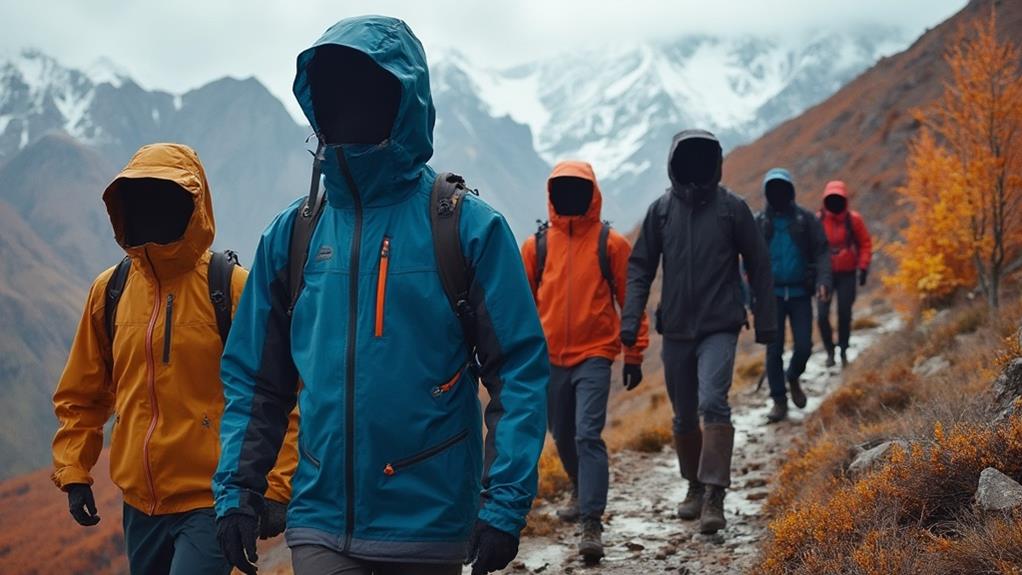
Selecting the right hiking jacket for windy and cold weather involves several key factors to assure peak performance and protection. Understanding insulation types is critical; down insulation offers an exceptional warmth-to-weight ratio, perfect for extreme cold, while synthetic insulation excels in retaining heat even when wet, making it suitable for unpredictable weather.
Additionally, jackets should feature breathable fabrics with a high Moisture Vapor Transmission Rate (MVTR) to efficiently manage perspiration during high-output activities, minimizing overheating and discomfort.
Adjustable features are essential to enhance fit and insulation. A jacket equipped with adaptable hoods, cuffs, and hems guarantees a snug fit, effectively blocking cold air and enhancing warmth retention.
Reflect on lightweight and packable designs that promote versatility and convenience, allowing for easy transport and quick deployment in variable conditions.
Key features to contemplate include:
- Insulation Types: Down for warmth-to-weight efficiency; synthetic for wet conditions.
- Breathable Fabrics: High MVTR for effective moisture management.
- Adjustable Features: Hoods, cuffs, and hems for a tailored fit.
- Lightweight and Packable: Enhances versatility and ease of transport.
- Durability: Robust materials to withstand rugged outdoor environments.
These elements collectively assure a jacket that performs effectively in windy and cold terrains.
Waterproof Jacket Ratings
When selecting a hiking jacket for windy and cold conditions, understanding the waterproof ratings is essential to guarantee adequate protection and comfort.
The hydrostatic head measurement is a critical factor, with a minimum of 20,000mm recommended for winter conditions to prevent water ingress.
Equally important is the jacket's breathability, assessed through MVTR and RET ratings, to maintain comfort by allowing moisture vapor to escape while retaining warmth.
Understanding Waterproof Ratings
Steering through the complexities of waterproof jacket ratings requires an understanding of the hydrostatic head (HH), an important metric that quantifies a fabric's resistance to water penetration.
In the domain of waterproof technology, the HH rating measures the height of a water column, in millimeters, that fabric construction can endure before allowing water to seep through. A minimum rating of 20,000mm HH is advisable for winter conditions to guarantee adequate protection against water ingress.
Premium fabrics like Gore-Tex offer ratings between 28,000mm to 30,000mm HH, providing superior defense against extreme weather.
Understanding the nuances of jacket features is significant:
- Waterproof Zippers: These prevent leaks, a common vulnerability point if left unsealed.
- Taped Seams: Important in reinforcing a jacket's waterproof capabilities, sealing potential entry points.
- Breathability Metrics: MVTR and RET are essential for comfort, particularly during high-output activities where moisture management is crucial.
- Fabric Durability: High HH ratings often correlate with robust fabric constructions that withstand harsh conditions.
- Interplay of Ratings: Balancing waterproof ratings with breathability guarantees comfort and dryness across varied climates.
Selecting a jacket that merges these elements guarantees weather-ready performance and comfort.
Impact of Hydrostatic Head
In the domain of high-performance hiking jackets, understanding the significance of the Hydrostatic Head (HH) rating is vital. This metric evaluates hydrostatic performance by measuring the height in millimeters of a water column that a fabric can endure before it allows water penetration. A higher HH rating signifies superior waterproof technology, an essential factor when selecting jackets for harsh winter conditions characterized by heavy rain and snow.
For hikers facing such environments, a minimum HH rating of 20,000mm is recommended to guarantee adequate protection and comfort. Fabrics rated above 30,000mm, such as the Fjällräven Bergtagen Eco-Shell, offer exceptional waterproof performance, making them ideal for extreme weather scenarios. These high-performance options provide reliable barriers against moisture, which is important in preventing discomfort and potential hypothermia during prolonged exposure to wet conditions.
Evaluating HH ratings is vital for consumers intent on optimizing their outdoor apparel. By understanding these ratings, individuals can make informed decisions that balance robust waterproofing with other technical aspects, such as breathability, thereby enhancing overall comfort and safety.
This knowledge is invaluable when facing the unpredictable elements encountered during hiking in cold, windy weather.
Importance of Breathability
Although a high Hydrostatic Head rating guarantees a waterproof barrier, breathability is equally crucial for maintaining comfort during strenuous outdoor activities.
Breathable materials play a significant role in moisture management by allowing perspiration to escape while preventing external moisture intrusion. This dual functionality is essential for hikers, as it enhances comfort during prolonged exertion in cold and windy conditions.
Breathability is quantified through metrics such as Moisture Vapor Transmission Rate (MVTR) and Resistance to Evaporative Heat Transfer (RET), with higher values indicating superior moisture management.
When selecting a hiking jacket, consider:
- Moisture Vapor Transmission Rate (MVTR): Higher ratings indicate better breathability.
- Resistance to Evaporative Heat Transfer (RET): Lower values suggest enhanced moisture release.
- Waterproof rating of at least 20,000mm HH: Guarantees protection without sacrificing breathability.
- Premium fabrics, like Gore-Tex: Balances waterproofing and breathability effectively.
- Ventilation features (e.g., pit zips): Enhance airflow, aiding moisture management.
In addition, the fit and design of a jacket can influence its breathability.
Opt for jackets designed with layering capabilities and ventilation features to further enhance moisture management.
Prioritizing these elements guarantees a comfortable hiking experience, regardless of weather conditions.
Breathability and Comfort
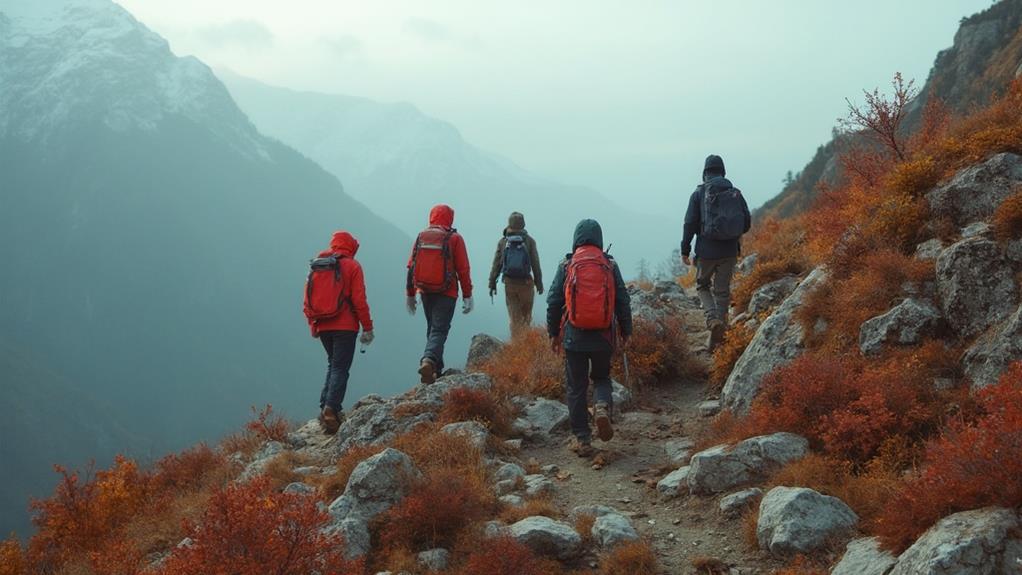
Breathability is a crucial factor in the design of hiking jackets tailored for windy and cold weather conditions. Effective layering techniques and moisture management are paramount for maintaining comfort during strenuous activities. Breathability is quantified by metrics such as MVTR (Moisture Vapor Transmission Rate) and RET (Resistance to Evaporative Heat Transfer). These metrics guarantee that sweat vapor escapes, preventing overheating and stabilizing body temperature during high-output activities like hiking. Jackets like the Haglöfs Spitz GTX Pro utilize advanced materials to achieve high breathability ratings, providing comfort without compromising wind and cold defense.
| Feature | Description | Benefit |
|---|---|---|
| MVTR | Measures moisture vapor escape rate | Prevents overheating |
| RET | Assesses resistance to evaporative heat transfer | Maintains comfort in cold weather |
| Advanced Materials | Used in high-quality jackets for superior breathability | Balances warmth and ventilation |
Insulated jackets must skillfully balance warmth and breathability. Down insulation offers an excellent warmth-to-weight ratio, whereas synthetic options enhance moisture management when damp. Proper fit is essential; it should accommodate layering without hindering movement, guaranteeing ideal comfort in adverse conditions. Selecting jackets with these features will enhance comfort and performance in challenging weather, allowing hikers to focus on their outdoor experience rather than their attire.
Best Windproof Options
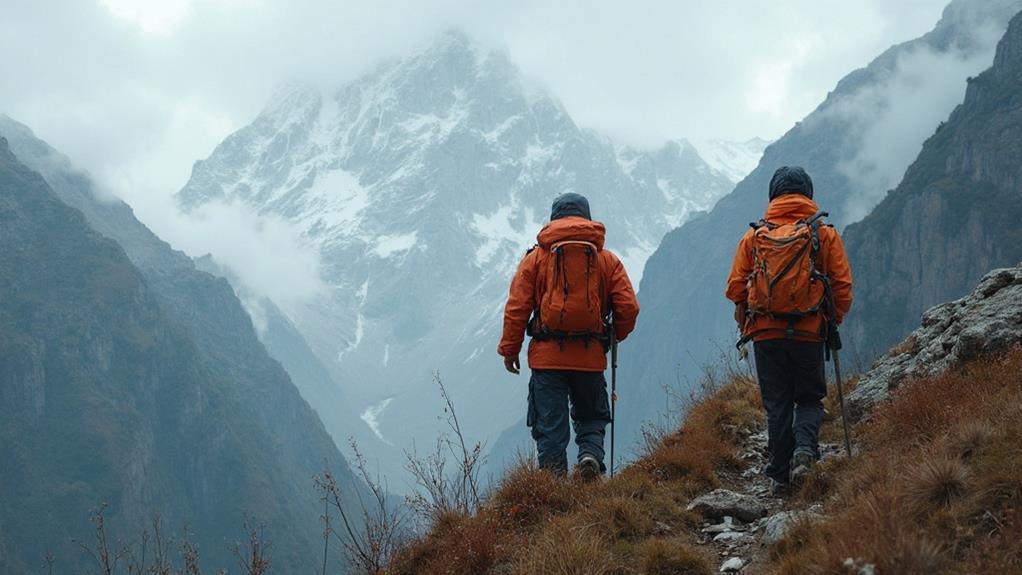
For those seeking superior windproof jackets, understanding the top windproof technologies and lightweight design elements is essential.
Jackets like the Black Diamond Distance Wind Shell, which weigh as little as 100g, exemplify cutting-edge materials and design features such as elasticated cuffs and hem toggles to guarantee maximum protection in windy conditions.
Additionally, options like the Alpkit Arro Windshell Jacket highlight the balance between effective wind resistance and portability, making them ideal for active outdoor enthusiasts who prioritize both performance and convenience.
Top Windproof Technologies
Among the most critical factors to consider when selecting hiking jackets for windy conditions is their windproof technology. Advanced wind resistance is primarily achieved through the use of specific fabric types. Tightly woven nylon fabrics are a common choice, offering a balance of wind blockage, lightweight properties, and breathability, which are essential for maintaining comfort during high-output activities like hiking.
Additionally, many jackets incorporate a Durable Water Repellent (DWR) treatment to further enhance their versatility in unpredictable weather.
When evaluating top windproof technologies, consider the following features:
- Fabric Composition: Tightly woven nylon materials are preferred for their superior wind resistance and breathability.
- DWR Treatment: Jackets with this treatment repel light rain and snow, broadening their usability.
- Performance Ratings: High scores in wind protection indicate effective shielding against wind chill, ensuring user satisfaction.
- Adjustability: Features like adjustable cuffs, hems, and hoods enable a customizable fit to maximize wind barrier efficiency.
- Practical Storage: Zipped pockets are essential for secure storage of essentials during outdoor activities.
The Black Diamond Distance Wind Shell and Patagonia Houdini are exemplary models, renowned for their lightweight construction and exceptional wind-blocking capabilities, making them ideal choices for enthusiasts seeking optimal protection.
Lightweight Wind Protection
When selecting a hiking jacket for ideal lightweight wind protection, it's important to take into account the balance between weight, breathability, and wind resistance. Lightweight windproof jackets, ranging from 100g to 575g, are best for outdoor activities where mobility and comfort are priorities.
For efficient layering techniques, these jackets serve as a significant outer layer, minimizing bulk while providing necessary wind protection.
Fabric choices play a considerable role in the performance of these jackets. Many options, such as the Black Diamond Distance Wind Shell, emphasize breathability and packability without sacrificing wind resistance.
Jackets often incorporate water-repellent finishes, which offer additional utility in light rain or snow, making sure that they maintain breathability while enhancing protection.
Design features, such as elasticated hems and cuffs, exemplified by the Sprayway Duin Jacket, are essential for preventing the entry of cold air, thereby maintaining warmth during windy conditions.
Popular models like the Adidas Terrex Agravic Windweave Jacket are engineered for active use, offering robust wind resistance tailored to both casual hikers and trail runners.
These technical elements guarantee that lightweight jackets are not only protective but also versatile for various outdoor scenarios.
Care and Maintenance Tips
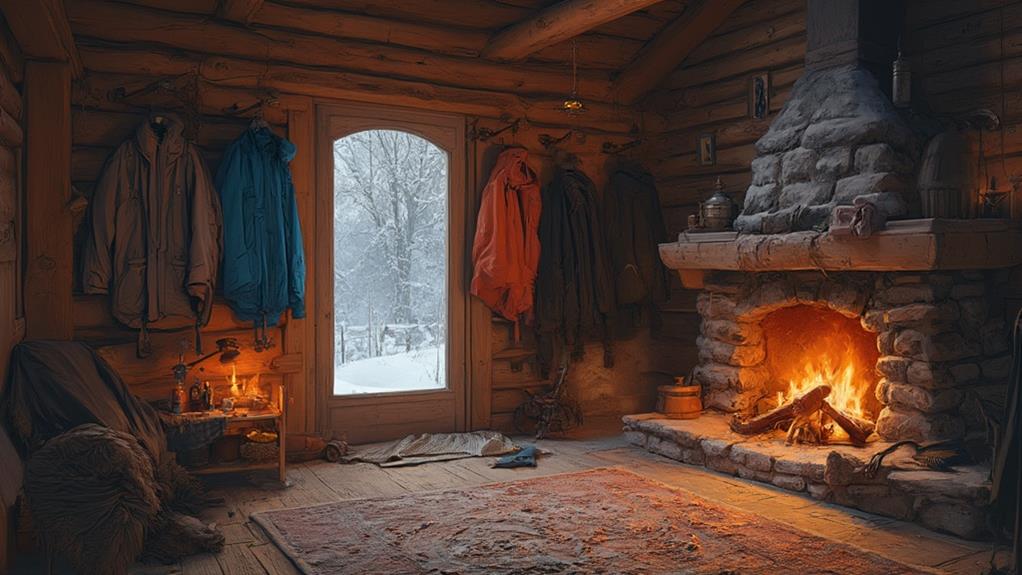
Proper maintenance of hiking jackets is vital for preserving their performance and longevity in challenging conditions. Effective care involves not only regular cleaning but also strategic storage and periodic inspection.
To guarantee peak functionality, it's important to adopt a meticulous approach to both cleaning frequency and jacket storage. Cleaning should be performed using water-based, PFC-free cleaners like Grangers or Nikwax, which enhance breathability and water repellency without compromising the jacket's material integrity.
Here are some detailed care and maintenance tips:
- Cleaning Frequency: Wash jackets according to manufacturer's instructions, typically on a gentle cycle, avoiding fabric softeners that can damage waterproofing.
- Jacket Storage: Store jackets in a cool, dry place, away from direct sunlight to prevent material degradation.
- Reproofing: Periodically apply reproofing treatments from brands like Grangers or Nikwax to restore water-repellent finishes and maintain fabric performance.
- Inspect for Wear: Regularly check zippers and seams for wear or damage, addressing weak points to enhance durability and functionality.
- Repair Services: Utilize repair services offered by many retailers for damaged jackets, promoting sustainability and extending gear life.
Pros and Cons Overview

Effective care and maintenance of hiking jackets guarantee they function at their best in adverse conditions, yet understanding their inherent advantages and limitations is equally important.
Windproof jackets, such as the Black Diamond Distance Wind Shell, excel in providing essential protection against wind chill. Their high score of 8.75 for overall performance underscores their effectiveness, particularly during high-output activities. However, these jackets may lack thorough waterproofing, necessitating strategic layering techniques to tackle variable conditions. Employing a combination of base layers and outer shells can greatly enhance temperature regulation and protection against precipitation.
Insulated jackets like the Mountain Equipment Trango are ideal for maintaining warmth in subzero temperatures, thanks to their dual layers of 700-fill down. This design offers excellent insulation, though the 1 lb. 10 oz. weight may be a consideration for ultralight backpackers.
On the other hand, lightweight options such as the Patagonia Houdini offer remarkable breathability and portability, easily packing into their own pocket. These are suitable for active users prioritizing ease of transport.
User Reviews and Feedback
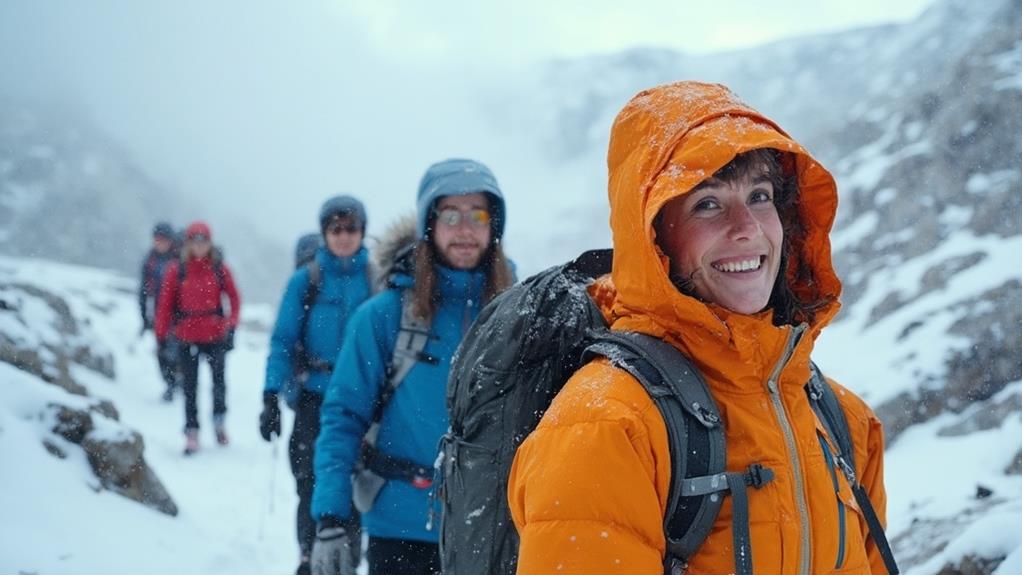
A multitude of users have shared insightful reviews on hiking jackets, offering a wealth of practical information for prospective buyers.
These reviews highlight key aspects of user preferences and fit variations, assisting users in selecting the most suitable outerwear for their needs.
Remarkably, the Black Diamond Distance Wind Shell is praised for its ultra-lightweight and packable design, weighing a mere 100g. This makes it ideal for individuals seeking minimal load during high-output activities in windy conditions.
Additionally, the Berghaus Taboche Jacket receives accolades for its windproof Gore-Tex Infinium fabric, which delivers superior wind protection even in adverse weather.
- Lightweight Design: Black Diamond Distance Wind Shell is favored for its minimal weight of 100g.
- Wind Protection: Berghaus Taboche Jacket excels with its Gore-Tex Infinium fabric.
- Versatility: Adidas Terrex Agravic Windweave Jacket blends wind resistance and breathability.
- Breathability: Patagonia Houdini is a top choice for maintaining airflow while blocking wind.
- Fit Preferences: Users report varied preferences, favoring either looser fits for layering or athletic cuts for streamlined movement.
Through these reviews, users can discern which jackets align best with their specific conditions and personal fit variations, ensuring a tailored outdoor experience.
Frequently Asked Questions
Which Type of Jacket Is Best for Extreme Cold?
For extreme cold, jackets with down insulation are ideal due to their superior warmth-to-weight ratio. However, layering techniques using jackets with synthetic insulation are recommended for wet conditions, ensuring sustained warmth and functionality through moisture retention.
What Kind of Jacket Is Best for Winter Hiking?
For winter hiking, jackets utilizing advanced insulation materials, such as down or synthetic fibers, are ideal. Effective layering techniques, incorporating windproof shells over insulated layers, enhance warmth and mobility, ensuring adaptability to changing weather conditions.
Are Windproof Jackets Worth It?
Windproof jackets are indeed worth the investment. Their advanced windproof technology and lightweight jacket materials provide superior protection and breathability, ensuring ideal warmth and comfort during outdoor activities in cold, windy conditions, while maintaining ease of movement.
Can a Jacket Be Windproof and Breathable?
Yes, a jacket can be both windproof and breathable by employing advanced fabric technology. Achieving a performance balance involves integrating breathable membranes and ventilation features, allowing for effective wind resistance without compromising moisture management during high-output activities.
Conclusion
To summarize, selecting the best hiking jacket for windy and cold conditions necessitates consideration of several critical features, including waterproof ratings, breathability, and windproof capabilities. The best options combine advanced materials and construction techniques to provide warmth, durability, and comfort. Proper care and maintenance enhance longevity, ensuring that performance standards are maintained over time. User reviews indicate varying preferences, but the outlined criteria serve as a reliable guide for making an informed decision tailored to specific environmental demands.